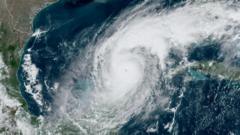Recent projections predict between six to ten hurricanes in the impending Atlantic season, coinciding with heightened alarm regarding federal budget slashes affecting crucial weather monitoring operations. NOAA indicates that 13 to 19 named tropical storms may form between June and November, creating conditions resembling a busy season, although not as severe as last year’s record. The primary drivers for this forecast include warmer sea surface temperatures and a lack of the typical El Niño conditions, which helps mitigate hurricane development.
Climate change has been implicated in the warming oceans that facilitate storm intensification, even as global increases in hurricane numbers are not assured. However, the Trump administration’s significant staff reductions at NOAA have sparked anxiety among scientists who view these layoffs as a barrier to effective storm tracking. With fewer researchers available, operational pressures mount, raising concerns about the overall readiness of weather services.
Long-term staffing cuts threaten to undermine improvements made in hurricane forecasting accuracy, according to researchers and climatologists. The National Weather Service is reportedly grappling with over 150 key vacancies, critical to maintaining consistent hurricane monitoring and response capabilities. As these cuts accumulate, experts warn of the possible consequences for local and global weather predictions, emphasizing the interconnected nature of atmospheric data collection.
“Less data means a worse forecast,” asserts meteorologist Matt Lanza, highlighting the emphasis on maintaining diverse observational networks. Overall, while operations continue under remaining personnel, critics stress that these systemic challenges, unless swiftly addressed, could culminate in heightened risks during crucial weather events. Efforts to maintain operational integrity remain paramount for ensuring public safety as hurricane season approaches.
Climate change has been implicated in the warming oceans that facilitate storm intensification, even as global increases in hurricane numbers are not assured. However, the Trump administration’s significant staff reductions at NOAA have sparked anxiety among scientists who view these layoffs as a barrier to effective storm tracking. With fewer researchers available, operational pressures mount, raising concerns about the overall readiness of weather services.
Long-term staffing cuts threaten to undermine improvements made in hurricane forecasting accuracy, according to researchers and climatologists. The National Weather Service is reportedly grappling with over 150 key vacancies, critical to maintaining consistent hurricane monitoring and response capabilities. As these cuts accumulate, experts warn of the possible consequences for local and global weather predictions, emphasizing the interconnected nature of atmospheric data collection.
“Less data means a worse forecast,” asserts meteorologist Matt Lanza, highlighting the emphasis on maintaining diverse observational networks. Overall, while operations continue under remaining personnel, critics stress that these systemic challenges, unless swiftly addressed, could culminate in heightened risks during crucial weather events. Efforts to maintain operational integrity remain paramount for ensuring public safety as hurricane season approaches.



















